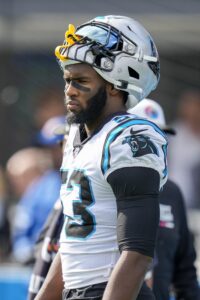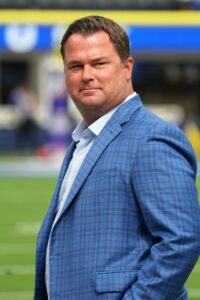The Rams’ 2016 trade-up for Jared Goff involved only picks being exchanged with the Titans, whereas the Falcons’ 2001 move for Michael Vick featured a player and draft choices going to the Chargers. Standout return man Tim Dwight went to San Diego in that deal. Ryan Poles preferred the latter structure, leading to the pre-free agency swap that featured D.J. Moore and picks going to the Bears.
Chicago’s second-year GM zeroed in on a picks-and-players package when he began dangling the No. 1 overall pick, Joe Person, Adam Jahns and Kevin Fishbain of The Athletic report (subscription required). The Bears had other targets beyond Moore. Unsurprisingly, they were the two other top trade chips that came up at last year’s trade deadline. Chicago also targeted Brian Burns and Derrick Brown.
[RELATED: Panthers Leaning Toward Bryce Young At No. 1?]
 Poles sought advice from Chicago Blackhawks GM Kyle Davidson, per The Athletic, citing the NHL as relevant reference material regarding trades involving picks and players. The Bears first heard from the Panthers on a trade, after Carolina — even though team brass met with Derek Carr at the Combine — determined a rookie passer would be the plan after three seasons of veteran retreads post-Cam Newton. Chicago also discussed the pick with Houston and Las Vegas, but Poles’ relationship with Carolina GM Scott Fitterer helped move the intra-NFC trade past the goal line.
Poles sought advice from Chicago Blackhawks GM Kyle Davidson, per The Athletic, citing the NHL as relevant reference material regarding trades involving picks and players. The Bears first heard from the Panthers on a trade, after Carolina — even though team brass met with Derek Carr at the Combine — determined a rookie passer would be the plan after three seasons of veteran retreads post-Cam Newton. Chicago also discussed the pick with Houston and Las Vegas, but Poles’ relationship with Carolina GM Scott Fitterer helped move the intra-NFC trade past the goal line.
The Panthers’ first offer included only picks, per The Athletic, but Poles informed Fitterer picks alone would not be enough to allow the Panthers to move from No. 9 to No. 1. Carolina pulled that proposal, and Burns, Brown and Moore came up. All three players emerged as targets at last year’s deadline — none more so than Burns, who drew a two-first-rounder offer from the Rams. The picks included in that proposal were in 2024 and 2025, however, leading the Panthers to pass.
“There were certain players that we never really wanted to trade,” Fitterer said, via The Athletic. “It’s so hard to replace a Derrick Brown or Brian Burns, a pass rusher [and] an interior, dominant young player on a [first] contract. D.J., we didn’t want to move either. But it’s a little bit easier to replace a receiver than it is a pass rusher or a three-tech.”
Burns is entering his fifth-year option season, while Brown is going into Year 4. Both players arrived before Fitterer did, but the team has long planned to hammer out an extension with Burns. Fitterer’s comments on Burns’ value stand to strengthen the defensive end’s negotiating position. The Panthers are aiming to do a Burns extension after the draft. They will likely target receivers in the draft, though signings of Adam Thielen and DJ Chark lessen that need a bit.
Prior to pulling off the trade with the Bears, the Panthers discussed prospective deals with the Cardinals for the No. 3 pick and the Seahawks for the fifth choice. Neither negotiation gained much steam, per Person, even given Fitterer’s lengthy past in Seattle. The Colts also checked in with the Bears, according to Jahns and Fishbain. That certainly adds up, given Indianapolis’ post-Andrew Luck history and both Poles and Colts GM Chris Ballard having worked together in Kansas City.
 The second-round picks exchanged here provided another interesting component in this seminal swap. The Bears wanted the Panthers’ No. 39 overall pick, according to The Athletic. Reluctant to part with it due to the gap that would exist between Carolina’s Nos. 1 and 61 overall picks, Fitterer counteroffered the 61st selection (obtained in the Christian McCaffrey trade) and a 2025 second. Instead of collecting one second-round pick, the Bears ended up with two in this trade — one that also will send Carolina’s 2024 first to Chicago. After David Tepper pushed for Deshaun Watson in 2021 and ’22, the Panthers determined this was the time to strike.
The second-round picks exchanged here provided another interesting component in this seminal swap. The Bears wanted the Panthers’ No. 39 overall pick, according to The Athletic. Reluctant to part with it due to the gap that would exist between Carolina’s Nos. 1 and 61 overall picks, Fitterer counteroffered the 61st selection (obtained in the Christian McCaffrey trade) and a 2025 second. Instead of collecting one second-round pick, the Bears ended up with two in this trade — one that also will send Carolina’s 2024 first to Chicago. After David Tepper pushed for Deshaun Watson in 2021 and ’22, the Panthers determined this was the time to strike.
“I think when you’re at No. 9 — hopefully we’re not at No. 9 moving forward — this was an opportunity that we felt like, ‘Hey, this is the highest, hopefully, that we’re going to be in the future, so let’s take advantage of this, let’s be aggressive,” Panthers assistant GM Dan Morgan said, via the Charlotte Observer’s Mike Kaye. “Let’s trade up and let’s try to go get our quarterback.”
Considering the Panthers have held top-10 picks from 2020-22, it is not as though holding the No. 9 choice was rare draft real estate for the struggling team. Matt Rhule led the charge for the Panthers to stay at No. 7 and pass on a QB in 2020, rather than leapfrog both the Dolphins and Chargers for Justin Herbert, and the Panthers — after a failed Matthew Stafford pursuit — traded for Sam Darnold in 2021. The 2022 draft featured a poorly regarded QB crop, leading to Carolina taking Ikem Ekwonu at No. 6.
As the Panthers determined they wanted a first-round QB, the Bears viewed this year’s crop as impressive but not to the point it would bail on Justin Fields and make him their avenue toward stockpiling future picks. Instead, the Bears will be targeting non-quarterback options at 9. Pass rusher will be a consideration.
“Play the percentage game, it’s probably a chance one [quarterback] slides in, but … there’s different tiers in the first round,” Poles said (via Jahns and Fishbain) of the prospect of more QBs going from Nos. 2-8 will help keep high-end position players on the board at 9. “There’s always that cut-off of ‘elite’ and then it’s ‘very good starters.’ I know we’ll be in range for the players that are going to be in that first round that kind of hit that value bucket and for our team are going to make us better.”
Carolina probably should’ve moved Brown instead if that was an option. Burns is the more valuable piece on defense, and Moore would’ve been a really nice top weapon to give the rookie from day 1. That QB’s development is all that matters now.
Prioritizing the defense over putting the best possible group of talent on the field around the #1 pick to help him succeed, is questionable, IMO.
If the rookie has his development hampered with a mediocre pass catching group, Brown and Burns together on the D Line doesn’t mean anything.
I don’t know.. I think your logic is sound, but maybe premature. Wait til after the draft and see how the WR/TE room looks then. There’s also a case to be made that a strong defense keeps a young QB from having to play from behind.
Carolina should have never made this deal. They should have tanked to get Williams or Maye (the hometown kid) next draft.